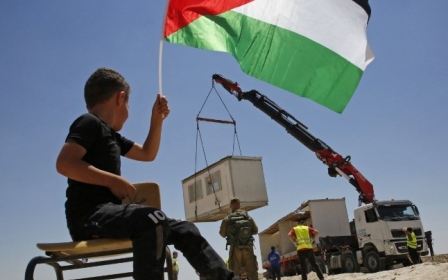Gaza needs the end of Israel's siege, not an economic 'fix'

Gaza's Great March of Return movement, which began more than three months ago, represents a shift in the Palestinian national struggle - especially in the besieged coastal territory.
After the 2014 Gaza war, Israel's right-wing government believed that it had successfully quashed resistance to its methods. The devastation wrought on Gaza in 2014 - including thousands of deaths and injuries, along with severe infrastructural damage - compounded pre-existing problems stemming from Israel’s assaults in 2008 and 2012.
Making matters worse, the ongoing siege of Gaza prevents the entry of many goods and restricts the movement of those goods, as well as individuals. This has hindered production and development operations in Gaza, relegating it to a captive consumer market in which most residents rely on UN assistance.
Stalled reconstruction
The Great March of Return movement highlights the refusal of Palestinians to cower in submission, despite the Netanyahu government’s best efforts.
Israel has taken many steps to try to secure that submission, including hampering the reconstruction process by preventing the import of construction materials.
Gaza’s protest movement has highlighted, for all the world to see, the brutality of the occupying force
The crisis in Gaza is manifested in the unprecedented rise in poverty and unemployment rates. Nearly half of the population is jobless, while the territory’s poverty rate has reached 80 percent. Thousands of students graduate from Palestinian universities in Gaza each year, but amid the ongoing humanitarian catastrophe and a severely weakened private sector, there are no jobs for them.
Gaza is also grappling with the repercussions of the internal divide between Hamas and the Ramallah-based Palestinian Authority, in addition to water pollution, inadequate medical facilities and power that is often unavailable for more than a few hours a day. In effect, Gaza has been transformed into a large "open air prison" that the UN says will be uninhabitable within the next couple of years.
The Great March of Return has fostered unity in the face of such challenges, bringing together political and social forces from across the spectrum. It has also increased international solidarity and added momentum to the Boycott, Divestment and Sanctions (BDS) movement, placing the Palestinian cause at the forefront of the world’s attention - after being sidelined for too long amid broader regional unrest.
Killed in cold blood
Gaza’s protest movement has highlighted, for all the world to see, the brutality of the occupying force. Children, women, elderly residents, paramedics, journalists: everyone is a potential target. Many demonstrators have been killed or injured in recent weeks, underscoring Israel’s ongoing human rights violations.
At the same time, the occupation government has attempted to discredit peaceful protesters, some of whom have sent fiery kites across the fence separating Gaza from Israel. Israel has tried to present the kites, which have damaged some fields, as violent military combat tools meriting a crushing, retaliatory air assault.
Israel's extreme response to the Great March of Return has hardened that movement's will. Resistance has spread to various areas of the West Bank and the diaspora, highlighting the power of the Palestinian national will in the face of occupation-driven displacement and geographic fragmentation.
This military and economic pressure coincides with regional and international moves ostensibly aimed at easing tensions and preventing the outbreak of a new war in the Gaza Strip. At a recent news conference in Gaza, Nickolay Mladenov, the UN envoy for the Middle East peace process, announced a plan to improve the economy and alleviate residents’ suffering.
Qatar has also been working to broker a truce in Gaza, including the possibility of a prisoner exchange, while the United States continues to promote its “deal of the century”.
Collective punishment
However, many observers believe that such measures address the outcome rather than the cause. The reason for the economic deterioration in Gaza lies in the Israel's siege and occupation. The international community must put pressure on the occupying state to end the siege, which constitutes collective punishment.
Humanitarian projects may lead to temporary improvements in Gaza, but without a broader solution to end the siege, the benefits quickly vanish. Real development requires the free movement of goods and people within an independent sovereign state that enjoys the right to self-determination. Anything else is a sop.
Israel has imposed on Gaza an atmosphere of war; the threat of a new attack looms every day. Air strikes on sites in Gaza, launched under the pretext of retaliation for the Palestinian kites, aim to end the protest movement without ever addressing the Palestinian demands for their right of return or a lifting of the siege. Israel wants Palestinians to prioritise social and economic issues over national and legal ones, but these things are entwined.
Israel's mentality of hegemony and arrogance is reflected in its will to impose a lasting siege and commit perpetual violations of Palestinian rights. The international community must pressure Israel to end this siege, instead of looking for partial economic fixes that enable Gaza struggle on as a giant prison.
- Mohsen Abu Ramadan is the former director of the Palestinian Non-Governmental Organisation Network (PNGO).
The views expressed in this article belong to the author and do not necessarily reflect the editorial policy of Middle East Eye.
Photo: A Palestinian worker holds a bag of cement during a protest against the Israeli siege in Gaza City on 1 May 2018 (AFP)
New MEE newsletter: Jerusalem Dispatch
Sign up to get the latest insights and analysis on Israel-Palestine, alongside Turkey Unpacked and other MEE newsletters
Middle East Eye delivers independent and unrivalled coverage and analysis of the Middle East, North Africa and beyond. To learn more about republishing this content and the associated fees, please fill out this form. More about MEE can be found here.






